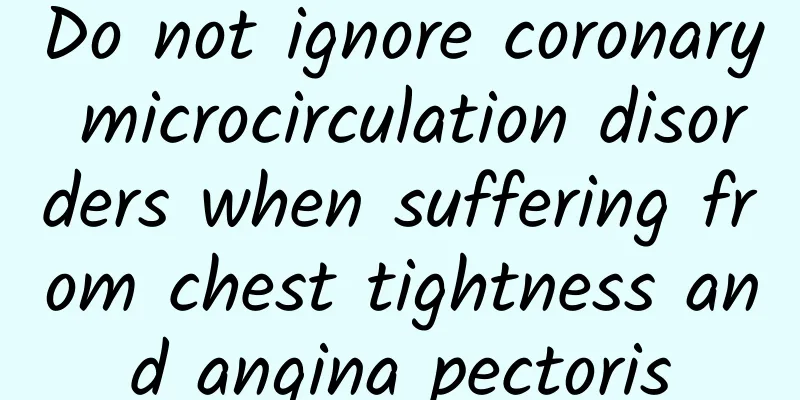Do not ignore coronary microcirculation disorders when suffering from chest tightness and angina pectoris

|
After the activity, I experienced chest tightness and angina pectoris, but the result of coronary angiography was negative, indicating that there was nothing wrong. So what exactly caused these uncomfortable symptoms? It is likely to be coronary microcirculation disorder. What is coronary microcirculation disorder? In fact, coronary angiography can only detect 5% of the coronary arteries, and the remaining 95% of the coronary arteries are invisible, called coronary microvessels. These invisible coronary microvessels are the main site of myocardial metabolism, which converts nutrients and oxygen transported by blood vessels into energy to maintain the beating and normal function of the heart. The heart is like a house, and the vascular system is the water system of the house. The 5% visible coronary arteries are equivalent to the main pipes of the water system, and the remaining 95% of the coronary microvessels are equivalent to the various levels of branch pipes. When nutrients supplied to the myocardium are transported from the main pipeline to the various branch pipelines, even if the main pipeline is unobstructed, if the branch pipeline at the lower level has problems and is blocked, it will eventually cause the water flow to slow down and affect the energy metabolism of the entire myocardium. This phenomenon is called coronary microcirculation disorder, which can also cause chest tightness and angina pectoris. How can we detect coronary microcirculation disorders? How can we detect microcirculatory disorders that cannot be detected by coronary angiography? Don’t worry, there is a “coronary microcirculatory resistance index test” that is very accurate! The Index of Microcirculatory Resistance (IMR) is an indicator used to quantitatively evaluate the coronary microcirculatory function. During the examination, a high IMR value indicates that the "small water pipes" may be blocked and the blood flow is not smooth; conversely, a normal IMR value indicates that the "small water pipes" are unobstructed and the blood supply is good. This is a minimally invasive examination technique. The doctor will insert a special catheter into the coronary artery through the patient's radial artery or femoral artery. After the catheter reaches the predetermined position, the doctor will quickly inject a certain amount of room temperature saline into the coronary artery, just like doing a "temperature test" for the heart and blood vessels. By measuring the flow rate and temperature changes of the saline in the heart and blood vessels, combined with the pressure at the distal end of the heart, the doctor can calculate the IMR value. The patient does not need to make special preparations. During the examination, he only needs to strictly follow the doctor's instructions to adjust his breathing and body position. When injecting saline, he needs to remain still. Experts suggest: Patients with undiagnosed chest tightness and pain, diabetes accompanied by numbness of hands and feet, and normal heart and large blood vessels but persistent palpitations and shortness of breath can undergo an IMR examination to identify microvascular problems that cause the "big water pipes" to be unobstructed but the "small water pipes" to be blocked. Tips: Precautions after IMR examination 1. Rest and observation: After the examination, the patient needs to follow the doctor's instructions to rest and closely observe the physical condition, especially whether there is any abnormality such as bleeding or hematoma at the puncture site. 2. Diet adjustment: After the examination, the patient can gradually resume his diet, but should avoid eating too greasy and irritating food to avoid gastrointestinal discomfort. It is recommended to drink more water to promote metabolism and the discharge of contrast agent. 3. Activity arrangements: Avoid strenuous exercise and heavy physical labor within 24 hours after the examination, and then gradually increase the amount of activity. 4. Psychological adjustment: Maintain a positive attitude and avoid negative emotions such as tension, anxiety and excessive stress. 5. Lifestyle advice: Eat a healthy diet, exercise regularly, control your weight, quit smoking and limit alcohol consumption. At the same time, learn to cope with and reduce stress, avoid factors that induce abnormal coronary blood flow, and have regular checkups. What should I do if I am diagnosed with coronary microcirculation disorder? Once coronary microcirculation disorder is diagnosed, there is no need to worry too much. Drug treatment can improve the condition. In addition, there are two "magic weapons" to help: extracorporeal counterpulsation and extracorporeal shock wave, both of which can promote blood circulation in the heart and blood vessels and improve heart function. EECP: It is completely non-invasive and is like an "external masseur" for the heart. It wraps special airbags around the patient's calves, thighs and buttocks, and these airbags "work" ingeniously as the heart beats. When the heart is resting, the airbags are pressurized to help blood quickly return to the heart, refueling the heart; when the heart is working, the airbags are quickly deflated to allow blood to flow smoothly throughout the body, reducing the burden on the heart, just like a perfect "massage treatment" for the heart. Extracorporeal shock wave therapy: It is a new type of non-invasive, painless, safe and effective angiogenesis therapy. If the heart is compared to a house, the myocardium is the wall of the house, providing support and protection for the heart. When the myocardium is damaged due to ischemia and the heart function declines, the extracorporeal shock wave therapy is like a professional "house repairman". It uses advanced ultrasound positioning technology to quickly and accurately locate the damaged myocardium, just like a "house repairman" locks on the damaged part of the wall at a glance. Then, by releasing low-energy shock waves, it is like a magical "little hammer" gently "knocking" the damaged myocardium, stimulating it to release growth factors and injecting special "repair materials" into the myocardium. These growth factors promote the growth of new blood vessels, just like building a new "water supply pipeline" for the house, ensuring that blood can be continuously transported to the ischemic myocardium, so that the damaged myocardium can be fully nourished and repaired, so that the "house" of the heart can be restored to its solidity and stability. Finally, I would like to remind you that chest tightness and angina pectoris, these seemingly common symptoms, may hide the hidden dangers of coronary microcirculation disorder. Don't let small problems become big troubles. Pay attention to them in time and receive scientific treatment to rejuvenate your heart. |
>>: Snoring makes you sleep better! Such rumors should be dispelled
Recommend
How to choose the best walnut kernels? Are walnut kernels high in calories?
Walnut kernels are rich in amino acids, proteins,...
Science and Technology Club talks about science | What should I do if I have hypoglycemia?
Through comics, we hope to help everyone better u...
Is it good to exercise during menstruation?
Every woman's body is different, and her mens...
The lochia is clean after 12 days and then comes back bright red
Postpartum lochia usually lasts for about 4 weeks...
How can a new mother judge whether the milk supply is sufficient? Why is the milk supply insufficient?
Regardless of whether it is breastfeeding or bott...
What kinds of birth control rings are there?
In order to prevent the harm of unmarried pregnan...
How old is considered advanced maternal age?
The term "elderly mother" should be ver...
The harm of women sleeping with the light on
For women, going to bed early and getting up earl...
How much is the amount of menstrual bleeding
Women with complete reproductive function have a ...
Counterpoint: iPad sales using Apple's self-developed M-series chips are expected to reach 20% in 2022
Apple is reportedly serious about turning its iPa...
What kind of fabric is plant fiber? What is plant fiber made of?
Fiber fabrics will become the fifth largest fiber...
Is it difficult to get pregnant with endometriosis?
Women are prone to many diseases, the most common...
Can I drink Huadiao wine during my menstrual period?
Huadiao wine is a very common type of wine. This ...
What kind of water should girls drink?
For some female friends, most of them have the pr...
Strategy Analytics: China's smartphone shipments in Q4 2021 were 83.8 million units, a year-on-year decrease of 6.5%
The latest research from Strategy Analytics shows...









